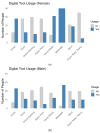Adoption of Technology in Older Adults in Mexico City: An Approach from the Technology Acceptance Model
- PMID: 40563802
- PMCID: PMC12191114
- DOI: 10.3390/brainsci15060632
Adoption of Technology in Older Adults in Mexico City: An Approach from the Technology Acceptance Model
Abstract
Background/objectives: Currently, older adults face significant digital exclusion due to a lack of technological skills, which limits their access to essential services and their social participation in an environment increasingly dependent on technology. This study aimed to analyze how technological anxiety and social influence affect the perceived usefulness, perceived ease of use, and adoption intention of technological tools among older adults in Mexico City using the Technology Acceptance Model (TAM).
Methods: A survey was conducted with 70 older adults attending an event in Mexico City.
Results: The findings confirm that, although perceived usefulness and ease of use remain pillars of technology use intention, technology anxiety acts as a critical barrier limiting adoption. At the same time, social influence has a dual effect: on the one hand, it facilitates the perception of ease of use; on the other, it diminishes the perception of usefulness when support becomes pressuring or impatient.
Conclusions: These results underscore the need to design interventions that reduce anxiety, strengthen digital literacy, and promote empathetic and motivating social support, thereby effectively enhancing technology adoption among older adults.
Keywords: anxiety; digital inclusion; digital technology; older adults; self-efficacy; technology acceptance model.
Conflict of interest statement
The authors declare no conflicts of interest.
Figures




Similar articles
-
Computer and mobile technology interventions for self-management in chronic obstructive pulmonary disease.Cochrane Database Syst Rev. 2017 May 23;5(5):CD011425. doi: 10.1002/14651858.CD011425.pub2. Cochrane Database Syst Rev. 2017. PMID: 28535331 Free PMC article.
-
Patient Perspectives on Digital Technology and Experiences of Computerized History-Taking for Chest Pain Management in the Emergency Department: CLEOS-CPDS Prospective Cohort Study.JMIR Med Inform. 2025 Jun 17;13:e65568. doi: 10.2196/65568. JMIR Med Inform. 2025. PMID: 40526888 Free PMC article.
-
Exercise interventions and patient beliefs for people with hip, knee or hip and knee osteoarthritis: a mixed methods review.Cochrane Database Syst Rev. 2018 Apr 17;4(4):CD010842. doi: 10.1002/14651858.CD010842.pub2. Cochrane Database Syst Rev. 2018. PMID: 29664187 Free PMC article.
-
Understanding older adults' adoption of facial recognition payment: An integrated model of TAM and UXT.PLoS One. 2025 Jul 10;20(7):e0325291. doi: 10.1371/journal.pone.0325291. eCollection 2025. PLoS One. 2025. PMID: 40638598 Free PMC article.
-
Home treatment for mental health problems: a systematic review.Health Technol Assess. 2001;5(15):1-139. doi: 10.3310/hta5150. Health Technol Assess. 2001. PMID: 11532236
References
-
- Abad Alcala L. Alfabetizacion Mediatica para la E-Inclusion de Personas Mayores. Dykinson; Madrid, Spain: 2017.
-
- Martínez Domínguez M. Acceso y uso de tecnologías de la información y comunicación en México: Factores determinantes. PAAKAT Rev. Tecnol. Soc. 2018;8 doi: 10.32870/Pk.a8n14.316. - DOI
-
- Quinde Barcia B., Mosquera González M., Vázquez Martínez A. Brecha Digital en Adultos Mayores: Accesibilidad Tecnológica y Redes Sociales. GIGAPP Estud. Work. Papers. 2020;7:744–757.
-
- Asociación de Internet 19° Estudio sobre los hábitos de usuarios de internet en México 2023. 2023. [(accessed on 17 December 2024)]. Available online: https://www.asociaciondeinternet.mx/estudios/habitos-de-internet.
-
- Tello E. Las tecnologías de la información y comunicaciones (TIC) y la brecha digital: Su impacto en la sociedad de México. [(accessed on 17 December 2024)];Rev. Univ. Soc. Conocimiento. 2007 4 Available online: https://rusc.uoc.edu/rusc/ca/index.php/rusc/article/download/v4n2-tello/....
Grants and funding
LinkOut - more resources
Full Text Sources

